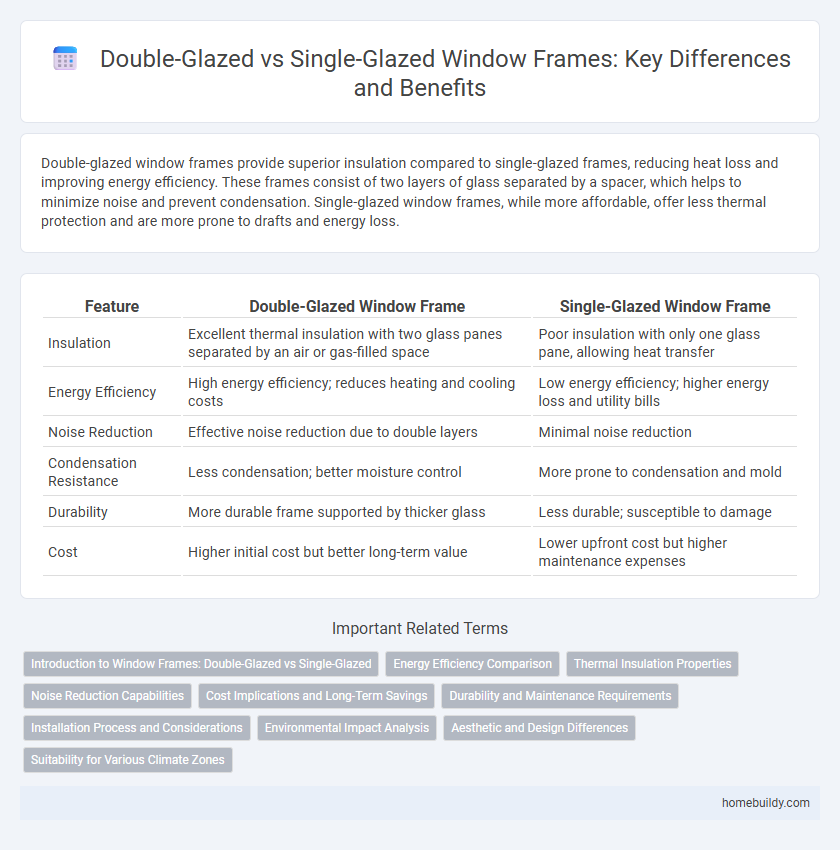Double-glazed window frames provide superior insulation compared to single-glazed frames, reducing heat loss and improving energy efficiency. These frames consist of two layers of glass separated by a spacer, which helps to minimize noise and prevent condensation. Single-glazed window frames, while more affordable, offer less thermal protection and are more prone to drafts and energy loss.
Table of Comparison
| Feature | Double-Glazed Window Frame | Single-Glazed Window Frame |
|---|---|---|
| Insulation | Excellent thermal insulation with two glass panes separated by an air or gas-filled space | Poor insulation with only one glass pane, allowing heat transfer |
| Energy Efficiency | High energy efficiency; reduces heating and cooling costs | Low energy efficiency; higher energy loss and utility bills |
| Noise Reduction | Effective noise reduction due to double layers | Minimal noise reduction |
| Condensation Resistance | Less condensation; better moisture control | More prone to condensation and mold |
| Durability | More durable frame supported by thicker glass | Less durable; susceptible to damage |
| Cost | Higher initial cost but better long-term value | Lower upfront cost but higher maintenance expenses |
Introduction to Window Frames: Double-Glazed vs Single-Glazed
Double-glazed window frames consist of two glass panes separated by a spacer, creating an insulating air or gas-filled gap that significantly enhances thermal efficiency and soundproofing compared to single-glazed frames. Single-glazed window frames feature just one pane of glass, offering minimal insulation and higher susceptibility to heat loss and noise penetration. Choosing double-glazed frames can improve energy savings, reduce condensation, and increase home comfort levels.
Energy Efficiency Comparison
Double-glazed window frames provide superior energy efficiency by incorporating two layers of glass separated by an insulating air or gas-filled space that significantly reduces heat transfer. Single-glazed window frames, with only one layer of glass, allow higher rates of heat loss and gain, leading to increased energy consumption and higher utility bills. The enhanced thermal insulation of double-glazed frames minimizes heating and cooling demands, contributing to lower carbon emissions and improved indoor comfort.
Thermal Insulation Properties
Double-glazed window frames feature two layers of glass separated by an air or gas-filled cavity, significantly enhancing thermal insulation by reducing heat transfer compared to single-glazed frames. This design minimizes heat loss in winter and heat gain in summer, leading to improved energy efficiency and lower heating and cooling costs. Single-glazed frames lack this insulating layer, resulting in higher thermal conductivity and less effective temperature regulation.
Noise Reduction Capabilities
Double-glazed window frames significantly enhance noise reduction by using two layers of glass separated by an insulating air or gas-filled space, which dampens external sound waves more effectively than single-glazed windows. Single-glazed window frames allow more sound transmission due to the single glass pane, making them less effective in reducing noise pollution. The thicker, layered construction of double-glazed frames improves acoustic insulation, making them ideal for homes in noisy urban environments or near busy roads.
Cost Implications and Long-Term Savings
Double-glazed window frames typically cost 30-50% more upfront than single-glazed frames due to their advanced insulation features and additional glass layer. However, they offer significant long-term savings by reducing energy bills by up to 25% annually through improved thermal efficiency and minimizing heat loss. Over time, double-glazed frames can recover the initial investment through lower heating and cooling costs, making them a cost-effective choice for energy-conscious homeowners.
Durability and Maintenance Requirements
Double-glazed window frames offer enhanced durability due to their thicker construction and improved resistance to warping and condensation compared to single-glazed window frames. Maintenance requirements for double-glazed frames are generally lower because the sealed units reduce moisture buildup and prevent mold growth, whereas single-glazed frames often need more frequent repairs and repainting to address weather-related damage. Investing in double-glazed frames results in long-term savings on upkeep and decreases the likelihood of frame deterioration.
Installation Process and Considerations
Double-glazed window frames require precise alignment and sealing during installation to ensure optimal thermal insulation and prevent moisture ingress, whereas single-glazed frames generally involve simpler fitting with fewer sealing requirements. The installation of double-glazed units demands careful handling due to their increased weight and thickness, often necessitating specialized tools and expertise. Proper consideration of frame material compatibility and securing techniques is crucial for both types to maintain structural integrity and maximize energy efficiency.
Environmental Impact Analysis
Double-glazed window frames significantly reduce heat transfer, leading to lower energy consumption for heating and cooling compared to single-glazed frames. This energy efficiency decrease in greenhouse gas emissions contributes to a smaller carbon footprint over the window's lifespan. Manufacturing processes for double-glazed frames typically involve more materials, but the overall environmental benefits from energy savings outweigh the initial resource use.
Aesthetic and Design Differences
Double-glazed window frames often feature thicker profiles to accommodate two panes of glass, providing a modern, robust appearance compared to the slimmer design of single-glazed frames. The enhanced insulation properties of double-glazed windows allow for larger glass areas without compromising energy efficiency, enabling sleek and expansive designs favored in contemporary architecture. Single-glazed frames typically support more traditional, minimalist styles but may limit creative glazing options due to structural and thermal constraints.
Suitability for Various Climate Zones
Double-glazed window frames offer superior thermal insulation, making them highly suitable for extreme climate zones with significant temperature variations. Single-glazed window frames are more appropriate for mild climates where insulation demands are lower and cost-efficiency is a priority. In cold or hot regions, double glazing reduces energy consumption by minimizing heat transfer, enhancing overall indoor comfort.
double-glazed window frame vs single-glazed window frame Infographic

 homebuildy.com
homebuildy.com